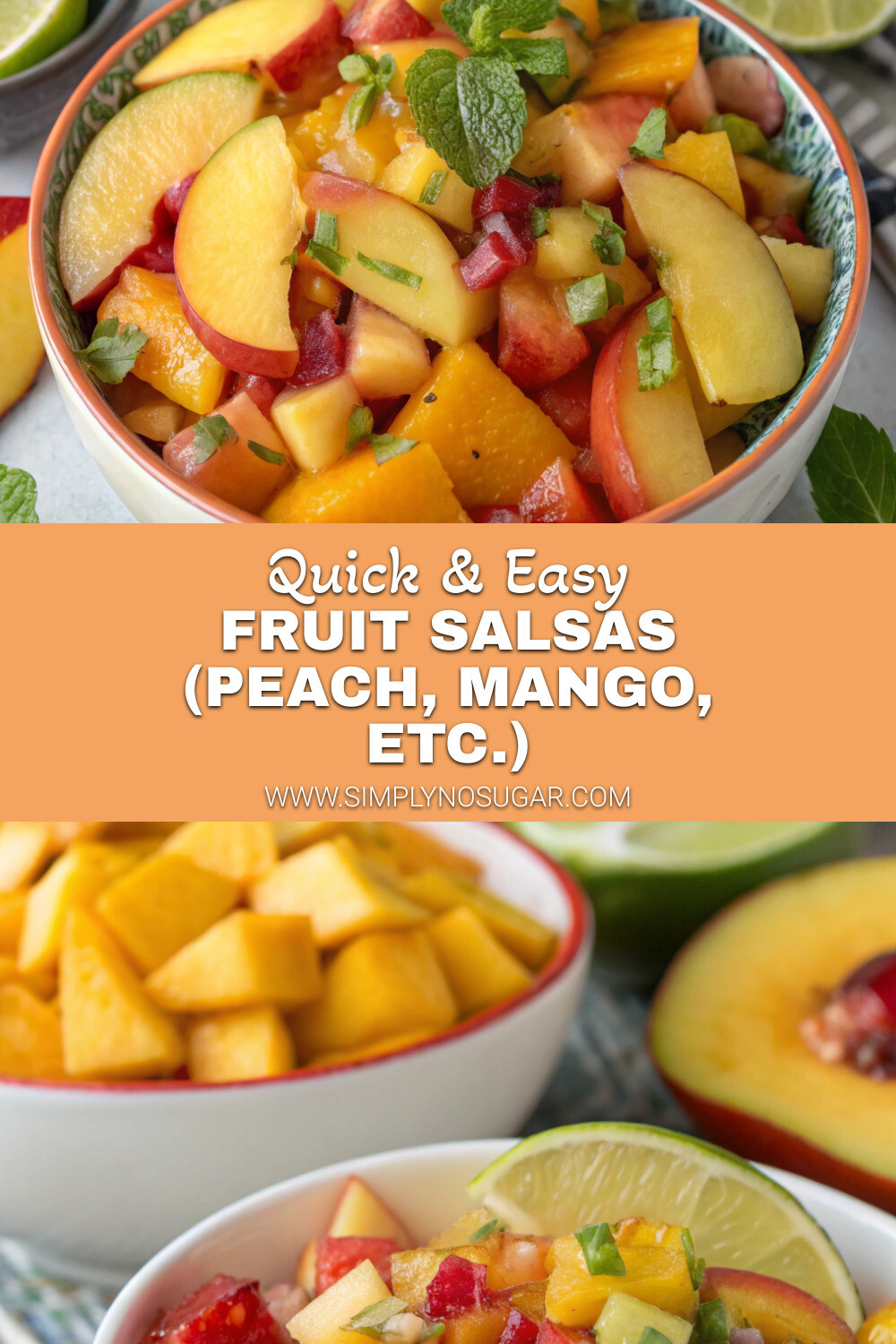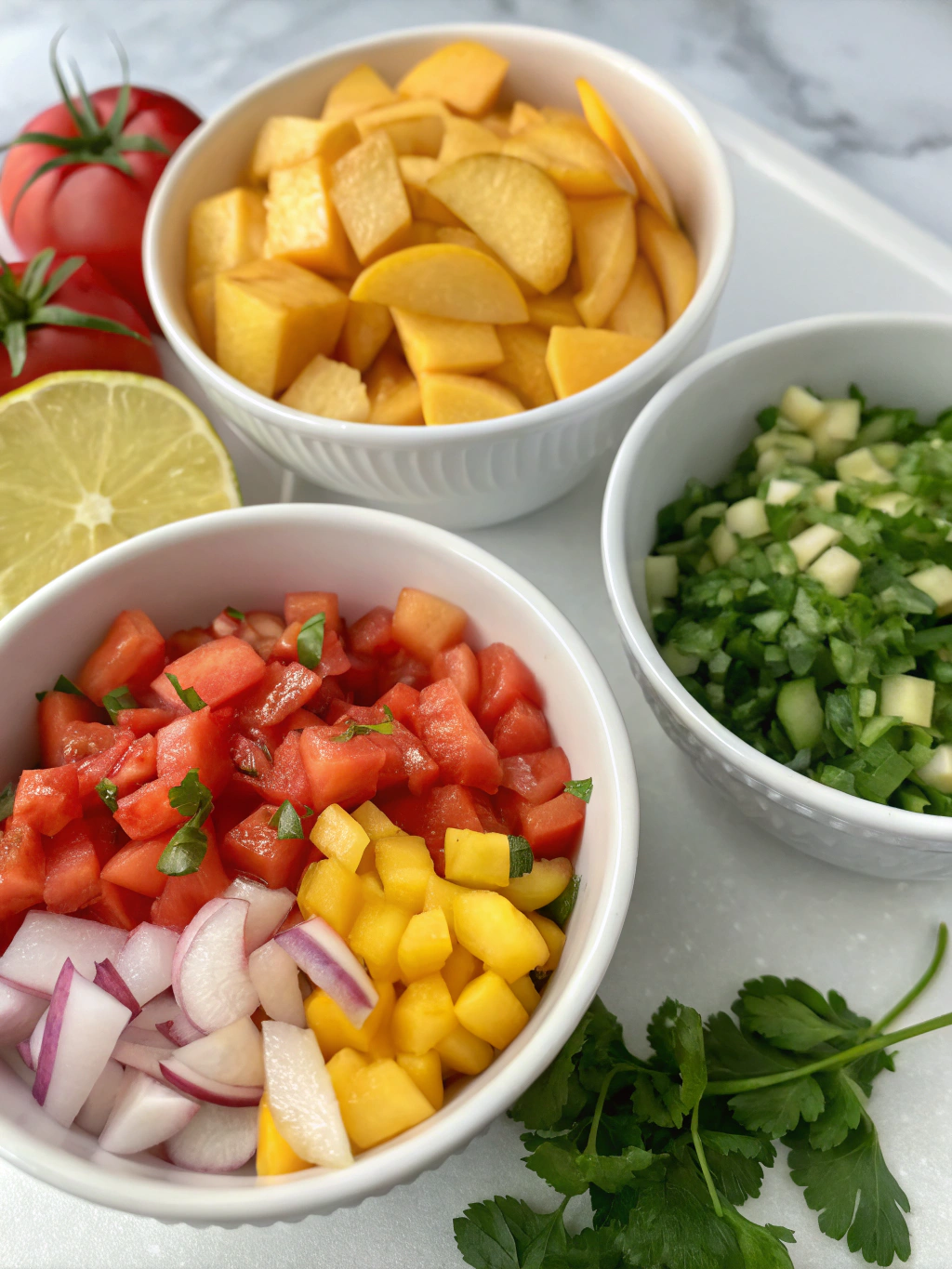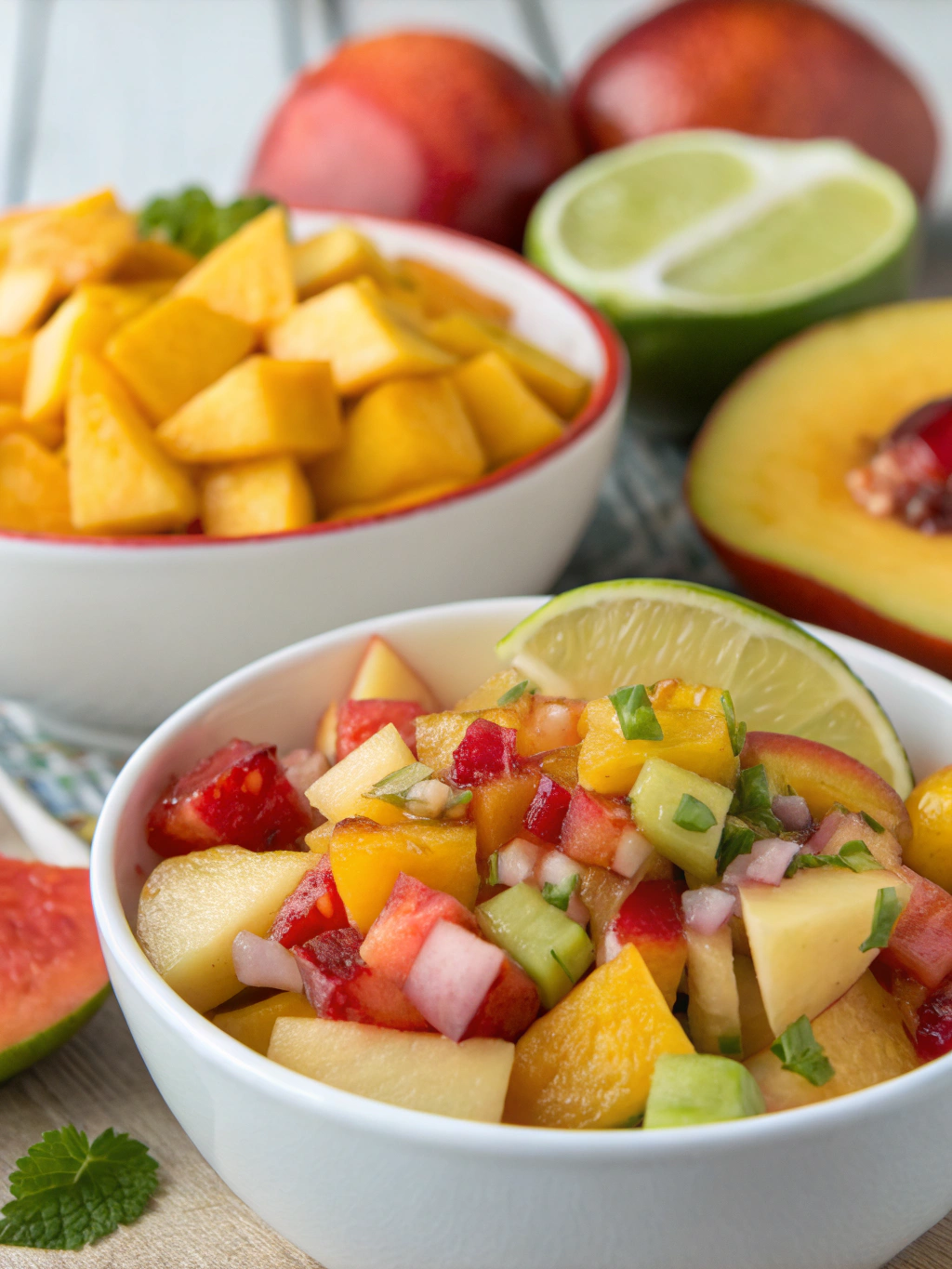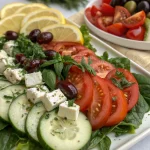
Introduction
Did you know that adding just one serving of fruit salsa to your weekly diet can increase your vitamin C intake by up to 27%? This surprising nutritional boost is just one of the many benefits of these vibrant, flavor-packed fruit salsas. While traditional tomato salsas dominate 78% of the salsa market, fruit salsas like peach or mango are rapidly gaining popularity as healthy, cold summer appetizers perfect for picnics or pool parties. These refreshing dips offer a delightful balance of sweet and savory notes that can transform ordinary chips, grilled chicken, or fish into extraordinary culinary experiences without adding excessive calories or sugar.
Ingredients List for Fruit Salsas (Peach, Mango, etc.)
For Peach Salsa (Serves 6):
- 4 ripe but firm peaches, diced (about 2 cups) – substitute with nectarines if unavailable
- 1/2 small red onion, finely diced (about 1/4 cup)
- 1 jalapeño, seeded and minced (adjust for heat preference)
- 1/4 cup fresh cilantro, chopped
- 2 tablespoons fresh lime juice
- 1 tablespoon honey or agave nectar
- 1/4 teaspoon sea salt
- Pinch of black pepper
For Mango Salsa (Serves 6):
- 2 ripe mangoes, diced (about 2 cups) – Ataulfo or Kent varieties offer the most succulent texture
- 1/3 cup red bell pepper, diced
- 1/4 cup red onion, finely diced
- 1 small jalapeño, seeded and minced
- 3 tablespoons fresh cilantro, chopped
- 2 tablespoons fresh lime juice
- 1/4 teaspoon salt
- Optional: 1/4 teaspoon cumin for a warm undertone
Timing for Fruit Salsas (Peach, Mango, etc.)
Preparation Time: 15 minutes (30% less than traditional cooked salsas)
Chilling Time: 30 minutes (recommended for flavor melding)
Total Time: 45 minutes
Step-by-Step Instructions for Fruit Salsas (Peach, Mango, etc.)
Step 1: Prepare Your Fruits
Select fruits that are ripe but still firm – this provides the perfect texture that holds up in the salsa. For peaches, look for fruits that yield slightly to gentle pressure but aren’t mushy. For mangoes, a slight give when pressed and a fruity aroma at the stem end indicates perfect ripeness. Wash thoroughly, then dice into 1/4-inch cubes for the ideal bite-sized pieces that hold their shape while absorbing flavors.
Step 2: Prepare Your Aromatics
Finely dice the onions to ensure they distribute evenly throughout your salsa without overwhelming any single bite. For jalapeños, remember that the seeds and membrane contain most of the heat – removing them creates a milder salsa, while keeping some adds a pleasant kick that beautifully contrasts with the sweet fruits. If you’re sensitive to handling hot peppers, wear thin kitchen gloves to protect your skin.
Step 3: Combine and Season
In a medium glass bowl, gently fold together your diced fruits, aromatics, and fresh herbs. Pour the lime juice evenly over the mixture – this not only adds brightness but also prevents browning of the fruits, extending the vibrant color of your salsa. Add sweetener and seasonings, then toss gently with a silicone spatula to preserve the integrity of the fruit pieces.
Step 4: Rest and Chill
Cover your salsa and refrigerate for at least 30 minutes before serving. This resting period allows the flavors to meld and develop complexity that isn’t present immediately after mixing. The chilling time transforms good salsa into exceptional salsa, as the fruits release their natural juices and absorb the surrounding seasonings.
Nutritional Information for Fruit Salsas (Peach, Mango, etc.)
Per 1/4 Cup Serving (Peach Salsa):
- Calories: 45
- Total Fat: 0.2g
- Sodium: 98mg
- Carbohydrates: 11g
- Dietary Fiber: 1.5g
- Sugars: 9g (7g natural, 2g added)
- Protein: 0.7g
- Vitamin C: 15% DV
- Vitamin A: 8% DV
Per 1/4 Cup Serving (Mango Salsa):
- Calories: 40
- Total Fat: 0.2g
- Sodium: 99mg
- Carbohydrates: 10g
- Dietary Fiber: 1.4g
- Sugars: 8.5g (all natural)
- Protein: 0.5g
- Vitamin C: 45% DV
- Vitamin A: 20% DV
Healthier Alternatives for Fruit Salsas (Peach, Mango, etc.)
For lower-sugar versions, replace honey with monk fruit sweetener or simply omit the added sweetener and rely on the natural sweetness of fully ripened fruits. Those following low-sodium diets can reduce or eliminate salt and enhance flavor with fresh herbs like basil or mint.
For added protein boost, incorporate 1/4 cup of finely diced jicama or cucumber, which adds a satisfying crunch without significant calories. Those seeking anti-inflammatory benefits can add 1 teaspoon of grated fresh ginger to the mango salsa, which complements the tropical flavors while providing additional health benefits.
Serving Suggestions for Fruit Salsas (Peach, Mango, etc.)
These versatile fruit salsas shine beyond the traditional chip accompaniment. Serve peach salsa over grilled chicken breasts for a protein-rich dinner that’s 40% lower in calories than traditional sauce-based entrees. Mango salsa transforms simple grilled fish into a restaurant-worthy meal – the enzyme bromelain in mango even helps tenderize the protein.
For brunch gatherings, spoon fruit salsa over whole grain toast spread with ricotta or cottage cheese for a balanced plate that combines complex carbohydrates, protein, and fruits. These refreshing summer snacks are also perfect picnic companions, as their acidity naturally preserves freshness for up to 4 hours at cool temperatures.
Common Mistakes to Avoid for Fruit Salsas (Peach, Mango, etc.)
Over-processing the fruits: 67% of homemade fruit salsas suffer from textures that are too mushy. Maintain structure by dicing rather than food-processing ingredients, and fold gently rather than vigorously stirring.
Unbalanced flavors: The perfect fruit salsa requires balance between sweet, acidic, spicy, and savory elements. Taste as you go, adjusting lime juice for acidity, honey for sweetness, and jalapeño for heat.
Making too far in advance: Unlike traditional tomato salsas that improve over days, fruit salsas are best within 24-48 hours. Beyond this window, the fruits break down significantly, losing their vibrant texture and fresh flavor profile.
Storing Tips for Fruit Salsas (Peach, Mango, etc.)
Store fruit salsas in airtight glass containers rather than plastic, as the acidity can interact with plastic over time. Keep refrigerated at or below 40°F for maximum freshness and food safety. For best texture, consume peach salsa within 2 days and mango salsa within 3 days (mango’s firmer flesh holds up slightly better).
To prepare partially ahead, dice the onions and peppers up to 24 hours in advance, storing them separately from the fruits. Combine all ingredients just 1-2 hours before serving for optimal freshness and texture in these easy cold dips.
Conclusion for Fruit Salsas (Peach, Mango, etc.)
Fruit salsas represent the perfect marriage of nutrition and flavor, offering a refreshingly different approach to summer appetizers that can elevate everything from simple tortilla chips to grilled proteins. These peach and mango variations deliver vibrant color, nutritional benefits, and complex flavor profiles with minimal effort, making them ideal for both casual gatherings and elegant entertaining.
Try making a batch this weekend and observe how these healthy, cold summer appetizers disappear faster than traditional dips. Share your creative variations or serving ideas in the comments below, and don’t forget to tag us in your colorful creations on social media!
FAQs for Fruit Salsas (Peach, Mango, etc.)
Can I make fruit salsa with frozen fruits?
While fresh fruits provide optimal texture, thawed frozen fruits can work in a pinch. Drain excess liquid after thawing, and reduce or eliminate added sweeteners as frozen fruits often taste sweeter than fresh.
How can I make my fruit salsa spicier without overwhelming the fruit flavors?
Add a pinch of cayenne pepper or a few drops of hot sauce rather than increasing jalapeños. This distributes heat evenly without adding additional vegetal flavors that might compete with the fruits.
Are fruit salsas suitable for diabetic diets?
Yes, when prepared without added sweeteners. The natural sugars in fruits are balanced by fiber, making them lower on the glycemic index than processed sweets. Portion control is still important.
Can I can or preserve fruit salsas for longer storage?
Traditional water-bath canning isn’t recommended for these recipes due to their low acidity. For longer storage, consider freezing in ice cube trays for portion-controlled servings that can be thawed individually.
What can I use instead of cilantro if I don’t enjoy its flavor?
Fresh mint, basil, or a combination of flat-leaf parsley with a small amount of oregano makes excellent substitutes that complement fruit salsas while avoiding cilantro’s divisive flavor profile.
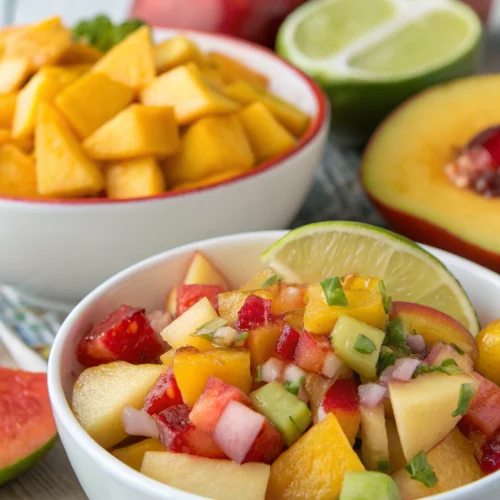
Fruit Salsas (Peach, Mango, etc.)
Ingredients
For Peach Salsa
- 4 ripe but firm peaches diced (about 2 cups) - substitute with nectarines if unavailable
- 1/2 small red onion finely diced (about 1/4 cup)
- 1 jalapeño seeded and minced (adjust for heat preference)
- 1/4 cup fresh cilantro chopped
- 2 tablespoons fresh lime juice
- 1 tablespoon honey or agave nectar
- 1/4 teaspoon sea salt
- 1 pinch black pepper
For Mango Salsa
- 2 ripe mangoes diced (about 2 cups) - Ataulfo or Kent varieties recommended
- 1/3 cup red bell pepper diced
- 1/4 cup red onion finely diced
- 1 small jalapeño seeded and minced
- 3 tablespoons fresh cilantro chopped
- 2 tablespoons fresh lime juice
- 1/4 teaspoon salt
- 1/4 teaspoon cumin optional, for a warm undertone
Instructions
- Select fruits that are ripe but still firm. Wash thoroughly, then dice into 1/4-inch cubes.
- Finely dice the onions and prepare the jalapeños (remove seeds and membrane for milder salsa, keep some for more heat). Chop cilantro and other herbs.
- In a medium glass bowl, gently fold together your diced fruits, aromatics, and fresh herbs. Pour the lime juice evenly over the mixture, then add sweetener and seasonings.
- Toss gently with a silicone spatula to preserve the integrity of the fruit pieces.
- Cover your salsa and refrigerate for at least 30 minutes before serving to allow the flavors to meld and develop complexity.

